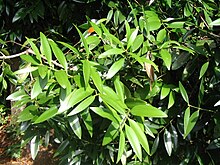Kauri trees
| Kauri trees | ||||||||||||
|---|---|---|---|---|---|---|---|---|---|---|---|---|

Damara tree ( Agathis dammara ), illustration |
||||||||||||
| Systematics | ||||||||||||
|
||||||||||||
| Scientific name | ||||||||||||
| Agathis | ||||||||||||
| Salisb. | ||||||||||||
| Sections | ||||||||||||
|
The Kauri trees ( Agathis ), also Kaurifichten or Kaurikiefern called, are a genus in the family of Araucariaceae (Araucariaceae).
description



Vegetative characteristics
Kauri trees are evergreen, very large trees . Under a spherical crown, they have strong stems. Young plants have a conical shape. The bark is smooth and gray to reddish. The branches grow horizontally or, in older specimens, they also point upwards irregularly. When the branches fall off, they leave round scars on the trunk. The buds are spherical with overlapping scales.
The seedlings have two lance-shaped cotyledons ( cotyledons ).
Leaves on young trees are larger and differently shaped than on mature trees. The leaves are arranged opposite or alternate or in a spiral on the branch. The leaves on adult trees are oval to linear in shape, flat, wide, leathery and thick with many parallel nerves and a short stem. Initially the leaves are reddish and later turn dark green, when they fall off, they leave a clear scar.
Generative characteristics
Agathis species are usually single sexed ( monoecious ). The male cones are cylindrical and have rounded scales at the base. Female cones are usually formed on short branches, they are rounded oval with many broad oval cone scales and take two years from pollination to maturity. The egg-shaped seeds have two (sometimes irregularly shaped) wings.




Locations
Agathis species colonize humid tropical rainforests and semi- evergreen monsoon forests , which have a dry period lasting several months. They grow at all altitudes from almost sea level to 2500 meters. In the plain, they can be found on very different soils: from sandy soils to limestone and volcanic soils to silicate soils. Most of the time they are the largest trees in a location, but in unfavorable locations they can also form a lower tier of a forest.
Systematics and distribution
The genus Agathis was established in 1807 by Richard Anthony Salisbury in Transactions of the Linnean Society of London , Volume 8, page 311. Type species is Agathis loranthifolia Salisb. Synonyms for Agathis Salisb. are Dammara (Rumph.) Lam. and Salisburyodendron A.V. Bobrov et Melikyan .
Agathis species are found only in the Pacific region from Peninsula Malaysia to New Zealand , including the Philippines , New Guinea , Melanesia, and Australia . They have a distribution from 10 ° 30 'N to 38 ° S and from 96 ° E to 180 ° E. All species except Agathis australis are only common in the tropics.
The genus Agathis Salisb. contains about 17 species:
- Agathis atropurpurea B. Hyland : It occurs only in the Australian state of Queensland .
- New Zealand Kauri Tree ( Agathis australis (D.Don) Lindl. ): The home is New Zealand's North Island.
- Agathis borneensis Warb. : The homeland is western Malaysia with Sumatra and Borneo.
- Dammara tree ( Agathis dammara (Lamb.) Poir. , Syn .: Agathis philippensis Warb. ): The home is parts of Indonesia and the Philippines , possibly also Vietnam and New Guinea.
- Agathis flavescens Ridl. : The homeland is the Malay Peninsula .
- Agathis kinabaluensis de foliage. : The home is Borneo .
- Agathis labillardieri Warb. : The home is New Guinea .
- Agathis lanceolata Warb. : The home is New Caledonia .
- Agathis lenticula de foliage. : The home is Borneo.
- Agathis macrophylla (Lindl.) Mast. : The home is Fiji , the Santa Cruz Islands and Vanuatu .
- Agathis microstachya J.F.Bailey & CTWhite : It is only found in the Australian state of Queensland.
- Agathis montana de foliage. : The homeland is northeastern New Caledonia.
- Agathis moorei (Lindl.) Mast. : The home is New Caledonia.
- Agathis orbicula de foliage. : The home is Borneo.
- Agathis ovata (C. Moore ex Vieill.) Warb. : The home is central and southeastern New Caledonia.
-
Queensland Kauri spruce ( Agathis robusta (C.Moore ex F.Muell.) FMBailey ): There are two subspecies:
- Agathis robusta subsp. nesophila Whitmore : It occurs from Papua New Guinea to New Britain .
- Agathis robusta subsp. robusta : It occurs from Papua New Guinea to eastern Queensland.
- Agathis silbae de foliage. : This endemic occurs only on Vanuatu .
swell
- Christopher J. Earle, 2019: Information on the genus at The Gymnosperm Database . (Sections systematics and description)
- Liguo Fu, Nan Li, Robert R. Mill: Araucariaceae in der Flora of China , Volume 4, 1999, p. 10: Agathis - online with the same text as the printed work , In: Wu Zheng-yi, Peter H. Raven (ed.) : Flora of China. Volume 4: Cycadaceae through Fagaceae. Science Press and Missouri Botanical Garden Press, Beijing and St. Louis 1999, ISBN 0-915279-70-3 . (Section description)
Individual evidence
- ↑ a b c d e f g h i j k l m n o p q r s Rafaël Govaerts (Ed.): Agathis. In: World Checklist of Selected Plant Families (WCSP) - The Board of Trustees of the Royal Botanic Gardens, Kew . Retrieved March 15, 2019.
- ↑ Walter Erhardt , Erich Götz, Nils Bödeker, Siegmund Seybold: The great zander. Encyclopedia of Plant Names. Volume 2: Types and Varieties. Eugen Ulmer, Stuttgart (Hohenheim) 2008, ISBN 978-3-8001-5406-7 .
Web links
- Agathis website. (English)
